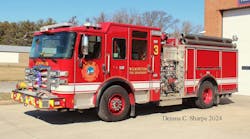In December 2008, on an icy winter night in Memphis, TN, a motor vehicle accident occurred on a local interstate highway. Nobody was driving fast because an ice storm was passing through the area. As ice and rain stuck to the ground, driving became very hazardous. People in Memphis are not used to seeing ice or snow, since cities in the mid-South are usually spared what winter can bring elsewhere. Even while driving slowly, the inexperienced snow-and-ice drivers found their cars slipping off the road. Hence, the cause of this accident.
When the 911 call came in, there was a report of minor injuries. A fire department ambulance was dispatched to the scene, as was an engine company as a first responder. Why dispatch an engine company as a first responder when minor injuries were reported? As is protocol in Memphis, an engine company is dispatched on highway calls to serve as a blocking tool to protect the scene — not necessarily to provide clinical work, but if called upon, the firefighters on the engine could perform clinical skills, since almost everyone in the Memphis Fire Department is an EMT and about half the apparatus are advanced life support (ALS) with firefighter/paramedics on them.
When the ambulance and the engine arrived at the scene, they were positioned properly. The engine was parked in back of the accident, at an angle, to block two lanes of the interstate and the accident scene. The ambulance parked in front of the incident, as is the protocol.
While all six firefighters on the scene were tending to the patient with minor injuries, an individual who had too much to drink plowed into the back of the engine at a high rate of speed. Firefighters raced to the occupant of the car, convinced the person probably was dead, since he hit the engine with a tremendous impact. He was not killed, but he was seriously injured and had to be cut out of the car. However, the firefighters would attest that they believe if the engine had not been parked there, they would have been killed.
What is the point of this story? Do not think that first response is just a clinical operation. Generally, sending fire apparatus as first responders is supposed to be a clinical decision. Generally, an ALS or a basic life support (BLS) engine or truck is dispatched to a medical emergency and its personnel are trained to provide medical intervention to someone who is sick or injured. Some departments send a first responder on every medical call and other departments use criteria-based dispatching to determine the nature of the medical call. If the type of call requires a medical first responder, the engine or truck company is dispatched.
The whole idea behind first response is to quickly get medically trained personnel to the scene to provide rapid medical intervention. But first response is more than that. First response by a fire department fulfills a variety of different needs or can perform different functions. As described earlier, blocking the scene of a traffic accident to provide protection for the responders working on the scene is just one function.
Usually, the fire apparatus will also carry the tools needed to perform vehicle extrication. Additionally, if an engine is dispatched to a vehicle accident, the crew members may mitigate any threat during extrication with their water supply because of fuels that may have been spilled. If forced entry must be made into a home, the fire apparatus also has the necessary tools.
Another feature of a first-response engine or truck is that people are available; the more people, sometimes, the better for the patient. This is especially true during a cardiac arrest. A lot of activity is going on at every cardiac arrest and the extra hands are always good to have. You never see a cardiac arrest run in the hospital with two people in the room.
But it does not have to be a serious medical or trauma emergency. Many times, extra hands are needed on patients with minor injuries too. Take the case of someone who slipped and fell on the second floor of a residence and has a suspected neck and back injury. If there was just an ambulance on the scene, the crew would have to bring immobilization equipment and a stretcher to the second floor. They would probably have to leave the patient's side to do this. But if an engine company was on the scene with four firefighters, all of these tasks could be completed much sooner, the patient would not be left alone and the extra manpower could be used to carry the stretcher down from the second floor.
First-responder companies, whether engine or truck, play a vital role in any emergency medical service system. Do not discount their value and do not view them in only one role.
GARY LUDWIG, MS, EMT-P, a Firehouse® contributing editor, is a deputy fire chief with the Memphis, TN, Fire Department. He has 32 years of fire-rescue service experience. Ludwig is chairman of the EMS Section for the International Association of Fire Chiefs (IAFC), has a master's degree in business and management, and is a licensed paramedic. He is a frequent speaker at EMS and fire conferences nationally and internationally, and can be reached through his website at www.garyludwig.com.





